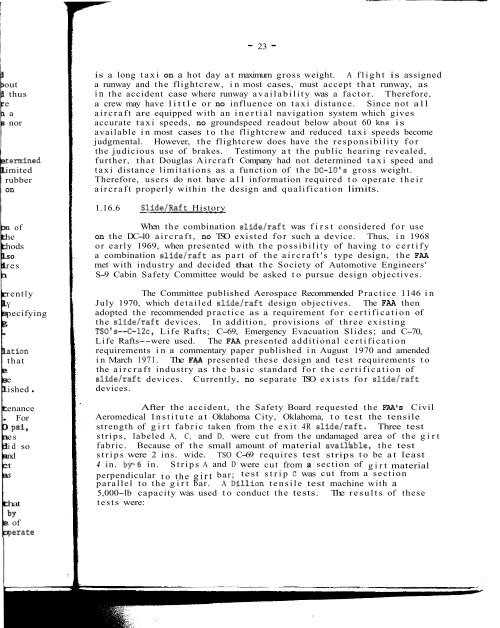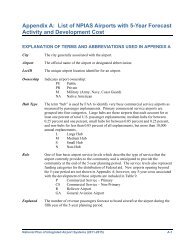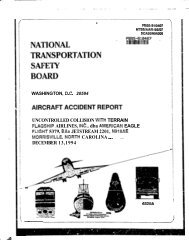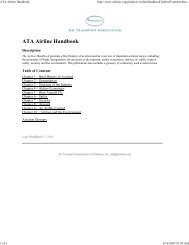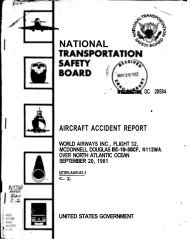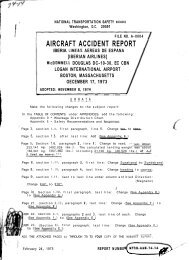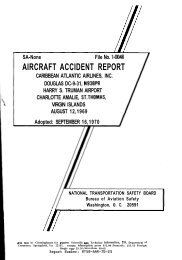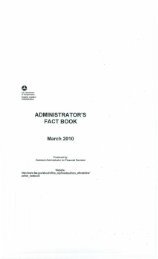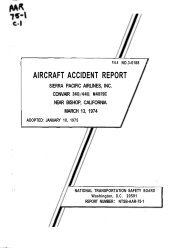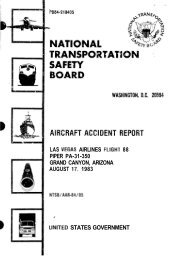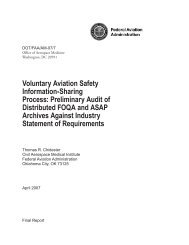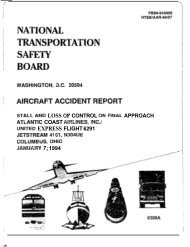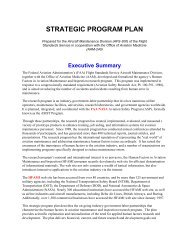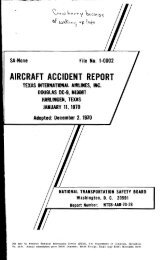Ntsb/aar-79-01 - AirDisaster.Com
Ntsb/aar-79-01 - AirDisaster.Com
Ntsb/aar-79-01 - AirDisaster.Com
Create successful ePaper yourself
Turn your PDF publications into a flip-book with our unique Google optimized e-Paper software.
out<br />
thus<br />
e<br />
a<br />
nor<br />
termined<br />
imited<br />
rubber<br />
on<br />
n of<br />
he<br />
hods<br />
so<br />
res<br />
rently<br />
Y<br />
pecifying<br />
ation<br />
that<br />
e<br />
ished .<br />
enance<br />
For<br />
es<br />
Psi,<br />
id so<br />
nd<br />
t<br />
S<br />
hat<br />
by<br />
of<br />
perate<br />
- 23 -<br />
is a long taxi on a hot day at maximum gross weight. A flight is assigned<br />
a runway and the flightcrew, in most cases, must accept that runway, as<br />
in the accident case where runway availability was a factor. Therefore,<br />
a crew may have little or no influence on taxi distance. Since not all<br />
aircraft are equipped with an inertial navigation system which gives<br />
accurate taxi speeds, no groundspeed readout below about 60 kns is<br />
available in most cases to the flightcrew and reduced taxi speeds become<br />
judgmental. However, the flightcrew does have the responsibility for<br />
the judicious use of brakes. Testimony at the public hearing revealed,<br />
further, that Douglas Aircraft <strong>Com</strong>pany had not determined taxi speed and<br />
taxi distance limitations as a function of the DC-10's gross weight.<br />
Therefore, users do not have all information required to operate their<br />
aircraft properly within the design and qualification limits.<br />
1.16.6 Slide/Raft History<br />
When the combination slide/raft was first considered for use<br />
on the DC-10 aircraft, no TSO existed for such a device. Thus, in 1968<br />
or early 1969, when presented with the possibility of having to certify<br />
a combination slide/raft as part of the aircraft's type design, the FAA<br />
met with industry and decided that the Society of Automotive Engineers'<br />
S-9 Cabin Safety <strong>Com</strong>mittee would be asked to pursue design objectives.<br />
The <strong>Com</strong>mittee published Aerospace Recommended Practice 1146 in<br />
July 1970, which detailed slidejraft design objectives. The FAA then<br />
adopted the recommended practice as a requirement for certification of<br />
the slide/raft devices. In addition, provisions of three existing<br />
TSO's--C-lZc, Life Rafts; C-69, Emergency Evacuation Slides; and C-70,<br />
Life Rafts--were used. The FAA presented additional certification<br />
requirements in a commentary paper published in August 1970 and amended<br />
in March 1971. The F&4 presented these design and test requirements to<br />
the aircraft industry as the basic standard for the certification of<br />
slide/raft devices. Currently, no separate TSO exists for slide/raft<br />
devices.<br />
After the accident, the Safety Board requested the FAA's Civil<br />
Aeromedical Institute at Oklahoma City, Oklahoma, to test the tensile<br />
strength of girt fabric taken from the exit 4R slide/raft. Three test<br />
strips, labeled A, C, and D, were cut from the undamaged area of the girt<br />
fabric. Because of the small amount of material avail'able, the test<br />
strips were 2 ins. wide. TSO C-69 requires test strips to be at least<br />
4 in. bjr6 in. Strips A and D were cut from a section of girt material<br />
perpendicular to the girt bar; test strip C was cut from a section<br />
parallel to the girt bar. A Dillion tensile test machine with a<br />
5,000-lb capacity was used to conduct the tests. The results of these<br />
tests were:


